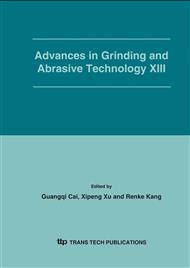p.364
p.369
p.374
p.379
p.384
p.389
p.393
p.398
p.403
Experimental Study on Mechanism and Performance of Magnetic Abrasive Finishing
Abstract:
Magnetic Abrasive Finishing (MAF) is relatively a new finishing technique that employs the magnetic force for finishing. In the paper, finishing mechanism of MAF is studied and four self-sharpening modes of abrasive particles are put forward. With the cylindrical magnetic abrasive apparatus designed and made by the author, a series of experiments on finishing the cylindrical surfaces of nonferromagnetic materials and ferromagnetic materials are carried out. The influence of technical parameters (finishing speed, feed speed, finishing time and so on) on finishing performance is analyzed. Choosing the optimized technical parameters, , the surface roughness of ferromagnetic materials changes from Ra 0.825µm to Ra 0.045µm after the 12-minute finishing experiment; the surface roughness of nonferromagnetic materials changes from Ra 0.434µm to Ra 0.096µm after the 20-minute finishing experiment.
Info:
Periodical:
Pages:
384-388
Citation:
Online since:
February 2006
Authors:
Price:
Сopyright:
© 2006 Trans Tech Publications Ltd. All Rights Reserved
Share:
Citation:


